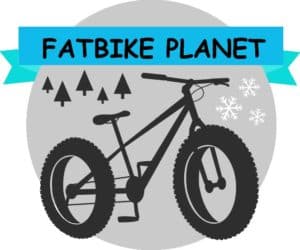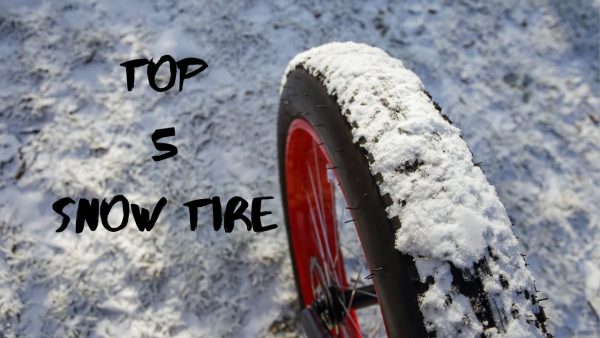It is very enjoyable to ride a fat bike in the snow. For some, this is the main reason why they purchase a bike like this in the first place. Many people want to see what they can do in the cold weather, and of course, with a terrain that is not exactly easy to navigate.
Below, we take a look at some of the best fat bike tires for snow right now. These tires are perfect for the trickiest of conditions. Instead of a person feeling like they are very vulnerable and could crash their bike at any time in bad winter weather, they know they have some amazing tires to count on below them.
1. Surly Bud and Lou Fat Bike Tires
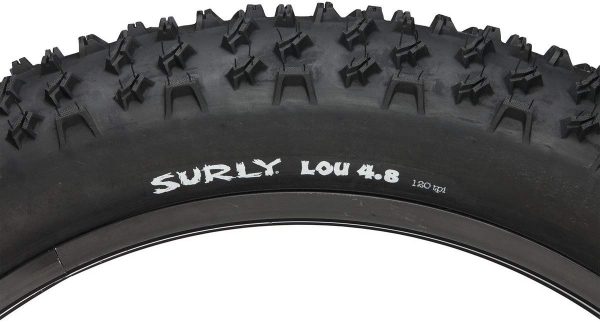
It is not always necessary to use a different tire for the front and back of a fat bike, but a lot of people who ride in the snow will go in this direction. That is because it offers a unique type of feel that a lot of people enjoy. The two tires have a few subtle differences that make one work well in the front, while the other works well in the back.
The Lou fat bike tire is the one that adds stability to the back. The Bud tire allows for quite a bit of maneuverability upfront, and in the snow, it is great to have that type of movement at all times. Some people feel like they might be a bit restricted with other fat bike tires, but this has the perfect amount of grip and overall freedom.
Both tires have a 7 mm tread that will tackle most accumulation of snow (within reason, of course) or well-groomed tracks. Even if snow is a little higher than normal, most people will find a way to navigate just fine.
Flexibility with sizing is another selling point of the surly Lou and Surly Bud tire. Each tire is 26 x 4.8“, and it fits rims ranging from 65 to 100 mm. This makes replacing tires currently on a bike that much easier.
The foldable tire has a Kevlar bead and a one-year warranty for people who might be hesitant to spend so much on tires in the first place.
It is a bit of an investment, but also a must for people who want to stay safe riding in the snow. Anyone who understands the importance of feeling locked in on a slippery surface will appreciate this setup.
Click here for the current price for the Surly Lou Snow Tires.
2. Vee Rubber 26×4.8” Snowshoe Fat Bike Tire
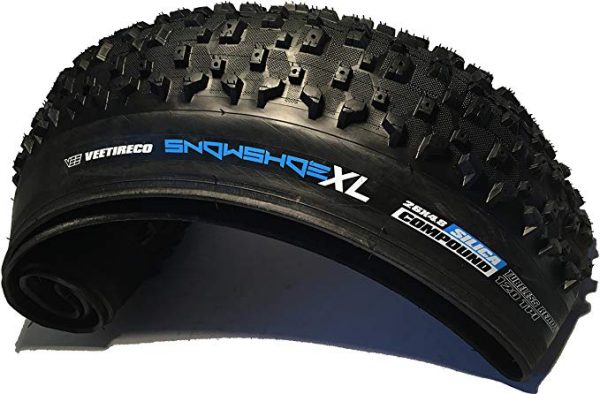
Some people will not ride in the snow without studs on the tire. While there are always ways to add studs after the fact, buying a bike with studs is usually the preferred method for the first time.
This is a very high-quality, yet affordable tire option from Vee Tire Co. that has enough variations to keep everyone happy.
The snowshoe comes in several different variations. The original version has a standard width, and no studs added to the tire. This still is a good option for people who ride the snow a lot, but it might not provide the same type of stability that a lot of riders are looking for. One thing it does do is come in under budget for those looking for a cheaper upgrade.
The XL version is a larger variation of the very popular snowshoe tire they originally came out with. It uses a rubber compound that has better ice performance than ever before. It is also a quieter tire that glides across snow when the set up is perfect.
Durability has also gone up with this newest version from the company. Instead of running the risk of possibly having severe damage done to the tire, people feel like they can be a little freer.
Having a very durable fat bike tire is certainly beneficial for any type of rider out there. It helps justify a higher cost of replacing tires in the first place.
Studs on these tires will cost a little more, but it is cheaper than adding them later on. The rubber does a good job of making sure their studs actually stay in place as well, which is always an added benefit. There are too many companies that have studded tires, but half of the studs fall out within the first few rides.
Click here for the current price for the Vee Rubber Snowshoe.
3. Maxxis Colossus
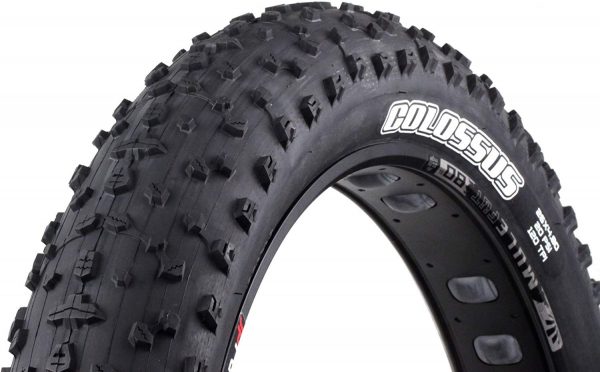
One of the biggest selling features of the Maxxis Colossus is the weight of the tire. This is a tubeless-ready option that weighs just 1.32 pounds, adding very little weight to a bike that already might be slightly heavy for some riders. It handles snow very well, even though they do not offer it with studs at the moment.
How does the tire perform so well? It all starts with a very wildly spaced out tread that clears out all the packed snow on the tire. There are enough tall knobs to help cut through the snow and provide a good amount of grip as well. It might not work quite as well as some studs, but it is still solid.
Finally, this tire performs very well in terrible conditions. Rubber compounds do not particularly like extremely cold weather, but this is a really great tire that does not show age too much.
A bonus feature of this tire is that it performs pretty well on hard surfaces in a crunch. Some people don’t like to ride their snow tires on hard surfaces because it might ruin them. There is no chance of doing that with these tires, as they are surprisingly durable for how inexpensive they are.
For those looking to stay under budget and still get a quality fat bike tire, this option from Maxxis is one to keep in mind. They are a company that provides some great tires at an affordable price. It stacks up against some brands that are twice as much.
Click here for the current price for the Maxxis Colossus Fat Bike Tire.
4. Terrene Cake Eater
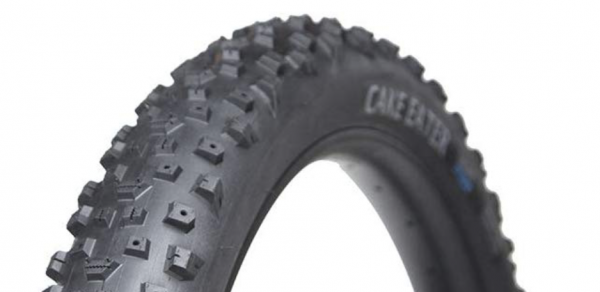
People who have speed on the mind should give the Terran Cake Eater tires a try. With studs on the tire for great traction and a fairly low center tread, people can fly on their bike with these tires. It handles snow and ice very well, giving riders confidence that they will not fall at any point.
It can be frustrating for people who are really craving speed to have to slow down when they are riding on their fat bike. It certainly pays off to be cautious to a certain degree, but these tires are the best for fat bike riders, not wanting to worry about falling over or crashing at any time.
If a person doesn’t need studded tires (lack of consistently heavy snowfall, personal preference, etc.), the company also offers versions without them.
These tires just don’t stand out as much as the ones with studs in them. They do a very good job of providing the right amount of support, and getting snow off of the tire when cutting through trails.
Click here for the current price for the Terrene Cake Eater.
5. 45nrth Dillinger 5
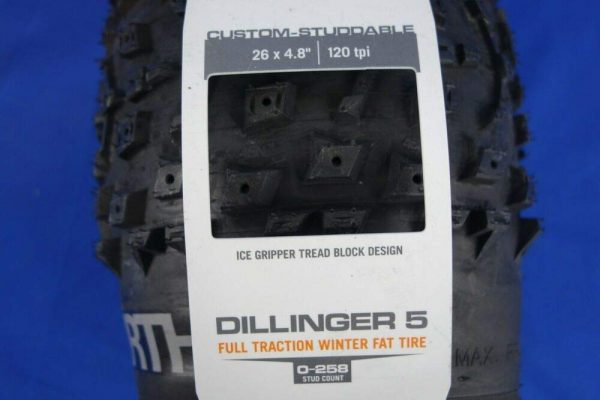
Saving perhaps the best for last, the Dillinger 5 is definitely a premium winter tire for fat bikes. The company has many products to support the fat bike community, and their tires always carry a great reputation.
The price tag is a little high, but consider the Dillinger 5 as a truly premium fat bike tire. The studs are as durable as any fat bike tire out there, which not only means fewer replacements but better grip from the very beginning. It handles ice particularly well, so anyone worried about hidden ice on the ride should give these tires a try.
The traction is so good on this tire that it feels like it is wider than 4.8 inches. Part of that comes down to the braced side lugs that improve cornering a lot. The entire tire provides great coverage for people as they try to stay as safe as possible.
Click here for the current price for the 45nrth Dillinger 5 Fat Bike Tire.
Common Questions In Regards to Fat Bike Tires For Snow
Now that the best are covered, some people still might have questions about these types of fat bike tires. The newer a person is to riding a fat bike, the more confused they might be.
Here’s a look at some of the common questions, with answers to clear everything up.
Why are specific tires for fat bikes needed?
After spending a good amount of money on a fat bike tire, some people could walk away pretty frustrated that they have to turn around and spend even more money on a specific set of tires. It might seem like overkill to the average rider, and the truth is, it is.
Investing in a very specific set of tires for the snow only makes sense for people who either take riding very seriously, or they know that they are only going to ride on this type of surface.
If riding on snow is only going to happen on occasion, there are ways to tweak current tires to make it more than fine.
What type of tire pressure makes the most sense in the snow?
Snow on the ground means a very low PSI for the tires. Many people would like to stay in the 5 to 8 psi range, depending on personal preferences, weight, the amount of snow, and more. Going lower than that is possible as well, as people should pay attention more to the feel than anything else. Don’t be too worried about how the gauge reads as long as it is pretty close to the range.
The last thing a person wants to do is really start to fill up their fat bike tires in the snow. That advantage of riding on very specific tires made for the snow goes away instantly as they sink into the surface. It will start to feel more and more like a legitimate struggle when trying to ride on a fat bike with too much air in it.
Is wider always better for the snow?
Any wide tire makes a big difference on soft surfaces like snow and sand. There is a reason why fat bikes are really dominating this section of bike riding.
A standard type of mountain bike won’t have the ability to handle the snow nearly as well. Tire surface area, without question, certainly helps.
Within reason, the wider the tire, the better off it will be to help with riding on snow. Feel is very important, so after just a few rides, even new riders will notice the difference. Some people will ease into fat bike tire riding with a tire width that approaches 5 inches or even goes beyond that. It takes some getting used to, but most people figure it out.
Can fat bike tires, designed for the snow, work on other surfaces?
It is recommended to try using specific fat bike tires on their designed surface. With that said, these tires are versatile enough that they will work on other surfaces as well. Just make sure to adjust a little for tire pressure if the ride will be more than something very brief.
The drawback of using a winter fat bike tire on a hard surface is that it won’t perform that well. There is also a chance of doing some damage to studs on a fat bike tire if it is constantly used on a hard surface. It will take a while to have a negative impact, but it will happen in time.
Are you riding in the snow a lot? Make sure to invest in a fat bike tire for snow. Out of all the updates out there available for people who ride a fat bike, upgrading tires to fit specific needs works best.
Final thoughts on shopping for fat bike tires for the snow
Before spending a lot of money on brand new tires specifically made for the snow, make sure that the current set up isn’t good enough. Some people just need to make a few tweaks with air pressure and maybe adding some studs to their current tires to see a difference.
If that doesn’t work, read up on reviews and get a feel for how people benefit from the different tires. It is hard to sample tires before they are on the bike, so reading and trusting reviews are key.
Any of the tires listed above work very well, and it mostly depends on what type of rider a person is when making the final choice.
